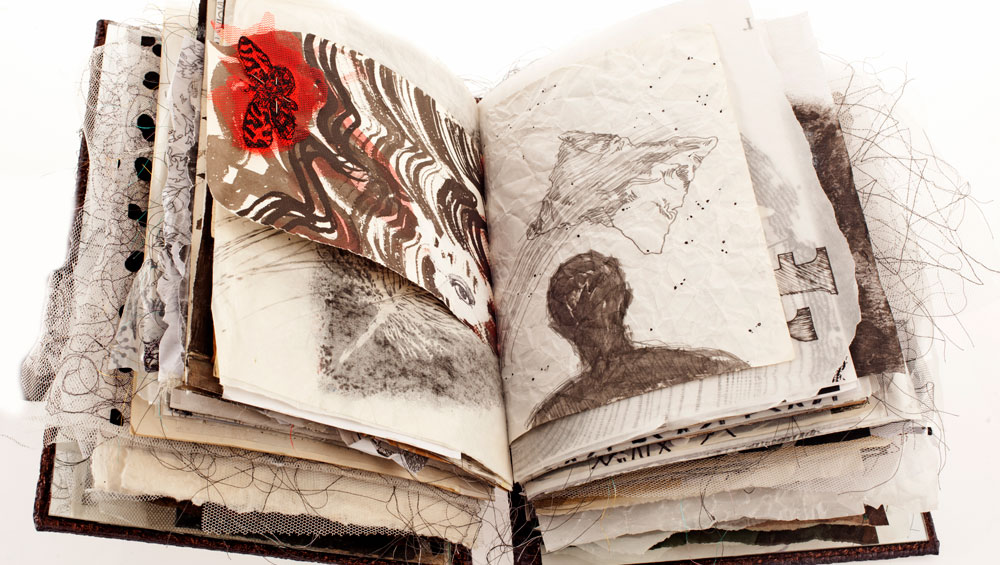
by JANET McKENZIE
Julie Montgarrett is a lecturer in creative arts and design at the School of Communication and Creative Industries at Charles Sturt University in New South Wales, Australia. Her art practice employs observational and imaginative drawing, collage and the assemblage of found items and the dyeing and manipulation of textiles and stitching to test the imagery of Australia’s problematic colonial past.
Journals, notebooks, photographs and details of archival historic documents initiate and direct the artist’s research. A search for objects and imagery of the colonial era in museums and archives in Tasmania, Sydney, Canberra and Melbourne, as well as some in the UK, Ireland and France, fuelled Montgarrett’s sketchbooks. The visits yielded information about history, geography, art and artefacts, but very little about the individuals she was researching. Australian artist Fiona Foley (b1964), a descendant of the Badtjala people (the indigenous inhabitants of Thoorgine or K’gari – Fraser Island – in Queensland) observes: “An absence of evidence is not evidence of absence.” Foley’s notion is of another substantial yet distant past that cannot be found in a museum or archive; rather it refers to the physical landscape of her ancestors; to a temporal expanse of cultural continuity and the present political debates that deny and silence the stories of Australia’s collective shame since colonisation.
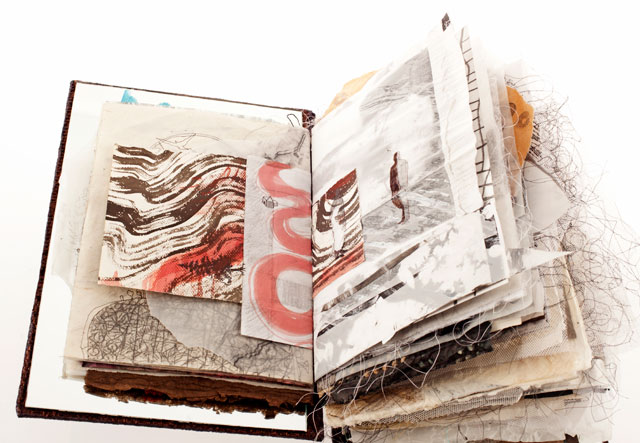
Julie Montgarrett. Jacob’s Book, 2013. © the artist.
Montgarrett seeks to negotiate the related non-indigenous issues of presence and absence, but employing the selective histories and mythologies of settler narratives. Adapting 19th-century landscape and still-life genres by incorporating sections, tracings and outlines of the conventional genres, and building on the silhouettes and symmetries with frottage, bush-dyed papers and cloth created by working on site at historic locations, she has created an alternative reading of the past. Her equivalent data combines with objects and fragments from museums and archives to serve to suggest relationships and implied meanings without closure. We met in Wagga Wagga in New South Wales.
Janet McKenzie: Your drawing is mostly in sketchbooks and much of it is created with sewn lines? When did you start making these sketchbooks, or are they artists’ books?
Julie Montgarrett: The sketchbook “habit” came about more than 15 years ago when I had been teaching full-time for about five years. Pocket-sized portable sketchbooks became a viable alternative to sustaining an ongoing creative practice as a readily accessible space in which to test ideas. I now have a collection of 30 or more of these small sketchbooks (A5 and A4 size) that run for almost a decade. They allowed me to think on paper. I then began a sustained series of sketchbooks where I used translucent pages – rice paper or glassine paper – to set up visual problems where an image on one page would ghost through to the next page, setting up a new visual problem to be negotiated, and neatly avoiding the blank page. This translucency, along with cutting through pages with window-like openings, preceded the later tulle, stitched pages.
I began to gather the fragments and scraps of imagery and diagrams from pre-photographic historical sources – museums and archives – to try to glean a sense of the minor historic characters whose lives were part of early-19th-century Van Diemen’s Land [now known as Tasmania]. The array of images and “samples” I gathered were based on extant domestic objects from the era or created at historical sites via frottage or bush-dyed cloth and papers to try to capture the colours and textures of the places in which the historical events occurred. These images on A3 pages were later folded into signatures and Coptic-stitched together into a kind of research reference file – somewhere between sketchbooks and artists’ books. The sewn lines, drawn freehand with a sewing machine, have been part of my practice for as long as I can remember so it was logical to bring that surface quality into the sketchbooks. Tulle was used to carry the stitched lines and almost suspend them in the air as well as to cast shadows when brightly lit. I have always gravitated to cloth and stitch – hand and machine as an extension of the drawn line and the rich textures of paper.
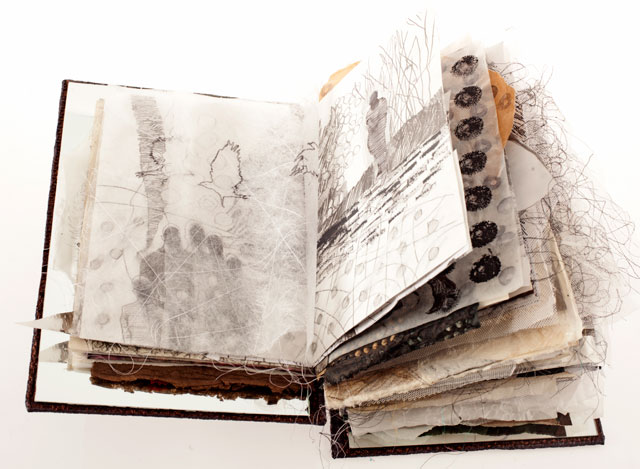
Julie Montgarrett. Jacob’s Book, 2013. © the artist.
JMcK: The narrative in your sketchbooks is visual research in to your own family in a pre-photographic era, but also a form of revisionist history? You discovered some startling information that is not in the standard histories of colonial Australia.
JM: The archives hold many clues and evidence of the real events of the colonial past that has been rewritten to craft a series of overlapping, convenient narratives that erase and deny the truth of the frontier genocide and dispossession and the facts of the subsequent intergenerational trauma that still haunts all Australians. The archives also reveal how many of the colonial heroes were, in fact, as equally inclined to criminality as were the convicts they brutalised, but privilege and power enabled them to hide their true intentions – to secure their land-holdings and wealth by any means necessary, including sustained genocide. What we most lack is a preparedness to seek out this clear evidence and bring it into the light and begin the process of acknowledging and accepting the truths of the colonial history.
JMcK: Can you explain your practice in relation to the last four sketchbooks?
JM: My initial data-gathering research for the sketchbooks via observational and imaginative drawing and related visual language devices, such as fragmentation, collage, spontaneity and chance, were combined as a series of artist’s books/sketchbook forms. These were produced after an intensive research trip to the UK, Ireland, France and Tasmania in 2011-12 using imagery drawn from observation of museum collections. On-site drawings of diverse artefacts found during this period of research included naval items – rigging, ropes, knots, boats and lanterns, and objects of a similar character and form to those of the era – simple, intimate domestic items, such as worn-edged spoons, discarded buttons, plain cups, basic chairs, dresses and coats of the period that conjured physical presence metonymically.
The first of those four sketchbooks, Salt-Ash and Cold, Cold Winds 2013 came from hours of scouring the microfiche archives of Northern Ireland, London, France and Australia to seek details of my cast of five characters and a story about the first 25 years of the British invasion of Van Diemen’s Land [in 1803]. At the centre of this story are five silhouettes and events that some call a colony and others a war zone. I have learned to call this a complex, conflicted uncertainty – far more than a binary collision of cultures.
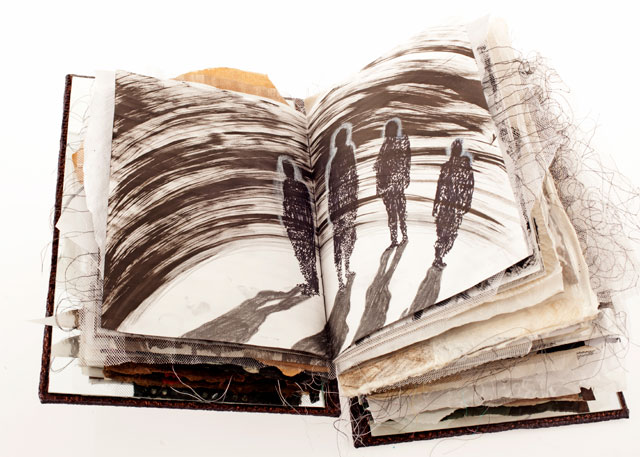
Julie Montgarrett. Jacob’s Book, 2013. © the artist.
The first silhouette is perhaps my great-great-great-great-uncle, Jacob Hackett Mountgarrett (1773-1828) – Irish-born, first “notorious” colonial surgeon, magistrate, doctor, destitute by the end of the second decade of British occupation of Van Diemen’s Land. Aside from a shared name, I cannot be completely certain of our relationship. Two centuries distant, these silhouettes are also a space of some anxiety for me – of both seeming complicity in relation to the first brutal years of colonial “settlement” and the euphemisms of slaughter revealed by the colonial archives, as much as a need to take responsibility for telling these hidden stories – to make sense of these lives beyond a stale and stereotypically drawn historical veneer.
The three main research sketchbooks include one each for Jacob Mountgarrett [Jacob’s Book, 2013]; Bridget Edwards, his wife; and George Briggs, a Straitsman and sealer who married Woretemoeteyenner, the daughter of Mannalargenna, one of the most significant Palawa leaders in Van Diemen’s Land. This poorly documented era is contradicted by mythologised, official historiographies so any possible alternative narratives remain incomplete, like unfinished sentences.
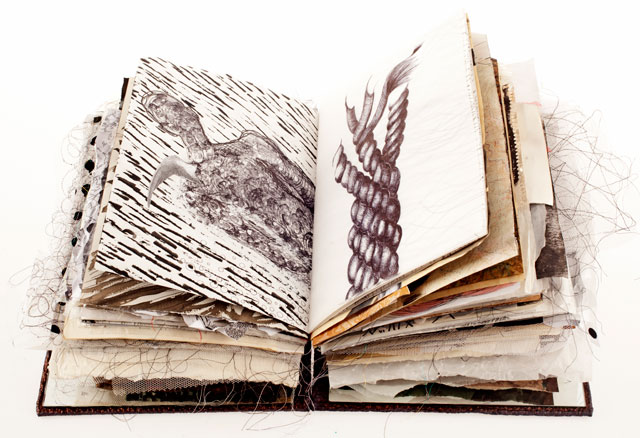
Julie Montgarrett. Bridget’s Book, 2013. © the artist.
Museum collections and the archives hold fragmentary evidence: unpretentious objects, tools, boots, uniforms; the creatures, maps and vessels of their likely uncertain encounters, perilous journeys and difficult circumstances were generally the only evidence of these lives lived out in the crossfire of an escalating war zone. To envisage this era requires an imaginative piecing together of the few “facts” and fragments to shape “What if?” scenarios and to perhaps create a different sense of these lives and experiences and, by comparison, some aspects of our own relationship to this distant past.
The resulting sketchbooks informed the final body of work for an exhibition that aimed to unsettle respectfully and rearrange imaginatively the fragments and narratives of the early colonial era. The research beyond the archives, however, at historic sites in Tasmania revealed the scale of the landscape, the light, the distances and the specific textures and colours of the rivers, shorelines and open country otherwise absent from the archival evidence. This on-site research engaged traditional artists’ research tools of sketchbook scale drawing – collages, bush-dyeing and frottage provided the most valuable haptic qualities towards representing a credible past to bring an important immediately tangible character to the final artworks. It also involved, at times, submerging sketchbooks entirely in the tidal zones of the coast and immersing the books in bush-dye pots to simmer for hours creating Rorschach-like stained pages.
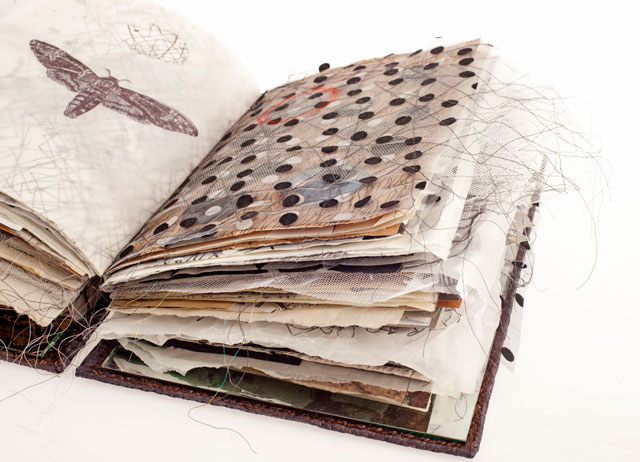
Julie Montgarrett. Bridget’s Book, 2013. © the artist.
Collectively, this visual and material evidence gleaned from drawing/collage/stitching based on archival artefacts, maps, large-scale assembled rubbings taken from built structures such as doorways, windows, gables, signposts and chimneys as remnant liminal spaces provided haptic clues that enabled the envisioning of the history otherwise hidden in both the archives and the landscape, but nonetheless still present. Through the sketchbook format, I also identified the potential of the negative spaces that arose through silhouette, symmetries and the gutters of the pages of sketchbooks while working on site. I recognised that the negative spaces and the gaps between fragmented imagery were the narrative. The gaps and absences between the edges of fragments presented uncertainties and doubts, and the viewer is obliged to make some sense of what they encounter.
[French sociologist and anthropologist Pierre Felix] Bourdieu’s [1930-2002] game of creative practice [he likened navigating the dynamics of power in society to playing a game], the type of focused attention in which outcomes are unpredictable, is usefully exemplified by my sketchbook research process by way of one series of small, headless sketches – anonymous characters with hands clenched or pointing, as if with agency; their feet positioned, as if grounded or weighted in an ambiguous place. Made spontaneously at the end of one day, as figurative forms, they were at odds with other imagery underway in the studio – a sustained series of studies of ropes and another of anatomical details as collage. As small, rapid, impulsive sketchbook gestures, these appeared without conscious intent – recognised later to be useful as life-size drawings. Their appearance without warning was congruent with [South African artist William] Kentridge’s space of negotiation between himself as artist and, most often, his animated gestural charcoal line drawings and erasures that build and dismantle worlds and identities.
Although I have included sections of extant artworks, conventional maps and convict illustrations of the colony (comparatively few extant images exist) as collage elements within the drawings, at sketchbook scale and within large-scale drawings, I have also included objects common to both this era and the present as fragmentary remains of history. These qualify as still-life elements from the sketchbooks and imaginatively operate as a form of portraits of the individuals who would have presumably used them on a daily basis. This is an anachronistic strategy – anachronistic here meaning visual elements that do not fit the dominant colonial narrative given that these humble objects were not worthy or significant objects for the conventions of Enlightenment still-life paintings, few of which (if any) were produced in the colony in the first two decades after settlement, and nor would these individuals have been likely subjects for portraits.
JMcK: How did you come to be a fibre artist and work with threads and fabrics?
JM: Postmodernism challenged modernism’s antagonism towards textile. Revising “the rules”, it granted contemporary artists permission to revisit the decorative and once again acknowledge textile’s astonishing diversity so embedded in human experience. I don’t remember who said to me: “The best art comes from making the unknown known and the known unknown.” A clumsy phrase, but worth remembering for textile is so known, so familiar and the familiar placed out of context is powerful. The shock of beautiful, trashed textile surfaces that can exquisitely communicate lived experience, pain and the passage of time, or domestic textiles that soar at architectural scale, disrupts expectations and enables us to potentially re-see the materiality. I have always gravitated to the seductive character and movement of cloth and thread. I recall my grandmother’s treadle sewing machine (I still use it) and playing with scraps of cloth from around the age of three with her. She was an exceptional seamstress and embroiderer, but she died when I was four, so there was no chance to really learn anything from her. But I was never taught the correct way to do anything, so I cut, folded, pinned and stitched my doll’s clothes in any way that worked with whatever was at hand. I guess it was a form of design learning along the lines of: “Start where you are; use what you have; do what you can.”
Later, I just intuitively included cloth, colour and the haptic character of all the textile elements and organic materials by way of painting, drawing and sculpture at art school. Painted surfaces were not enough, so I began to stitch into and on to cloth to enhance the drama of the haptic surfaces, and there was always just a tad more power in the colours and lustres of threads. When I got to RMIT [Royal Melbourne Institute of Technology] University to enrol in a graduate diploma in embroidery, the world tilted on its axis and I discovered a studio discipline that located textile between sophisticated industrial textile design processes; fashion where cloth is fundamental to the making of the sculptural form and creative arts. All of which recognised that the best works arise from the space between design and art as one challenges and informs/leads the other. I learned a whole raft of excellent skills across dye, print and machine embroidery that made any idea possible.
JMcK: For the past 10 years, you have worked extensively with the Wiradjuri people in the Riverina, New South Wales. How did your relationship begin?
JM: It began after Australian artist and academic Dr Cath Bowdler, who had been working in Arnhem Land [in the Northern Territory] and at the Northern Centre for Contemporary Art, Darwin for many years, employed an indigenous trainee curator, Melanie Evans in 2009 to develop a stronger relationship with the local Wiradjuri community.
As a result of this new direction, Melanie and the education officer at Wagga Wagga Art Gallery, Linda Elliott asked me if I would come and teach a small group of Wiradjuri women Elders how to make baskets. They were looking to set up a project to re-establish the traditions of weaving in the region, which were largely lost. I had learned to “weave” at primary school (with an Elder from Lake Tyers, Gippsland, in Victoria) and had spent a lot of time working in communities across the Northern Territory in 1983 when I was an artist in residence for the Crafts Council of the Northern Territory for six months. Later, in my first years at CSU [Charles Sturt University, NSW] I had learned from [Ngarrindjeri artist and weaver] Ellen Trevorrow and [Ngarrindjeri artist] Yvonne Koolmatrie at Camp Coorong Race Relations Cultural Education Centre how to weave with sedge and to make traditional Ngarrindjeri-style coiled baskets (scoops and eel trap forms), which were the basis for teaching the Elders in Wagga Wagga in 2009.
Working with the Elders has taught me that the simple process of making a basket that begins with a circle of thread and a bundle of reeds, and sometimes sea-grass, raffia or paper twine, is far more than a simple technique. As a needle eye carries the supple, resilient thread-line again and again through that space joining the rows, it is also symbolically moving across place and time, mending a loss of culture and is a vital key to cultural renewal. While the materials change by circumstance, these circles of thread of the basket and the circle in which the weaving takes place, remain. The baskets and woven forms are vital to the process of shaping meanings of culture and identity. They are also a crucial part of a process of repair; towards an invisible mending of Australian Aboriginal culture disrupted by British invasion and communities damaged by subsequent brutality, dispossession and grief.
Recent research has shown that both enriched and impoverished environments have a psychological and physical effect on us. Our sense of wellbeing and resilience are immediately affected as our brain responds to certain experiences and places. A deep and focused involvement in weaving, for example, can change the way we look at things. This change can create a quiet but valuable difference in our perception as it alters and refocuses our awareness, allowing us to be relaxed and alert at the same time. A close focus on making takes attention away from the relentless chatter and worries in our minds. It is even better if that making has a resonance in deep time with generations past. It is a great privilege to participate in the making of these new baskets – to learn, listen and begin to understand the vitality of a kind of invisible mending.
JMcK: What impact on your work have the Wiradjuri women had?
JM: So many answers to that question. It has revealed many levels of relationship to this tenuously beautiful but scarred Wiradjuri country, reduced so much in 200 years of industrial-scale European agriculture. Sharing bush-dyeing techniques with the Elders has brought me to a different understanding of both basket forms (weaving) with plant fibres and bush dyeing as processes that I have not rigorously questioned for years. Since 1998, I had been using colours of specific places and seasons on wool, and, more recently, I have been working with Melanie Evans and [basket-weavers and Wiradjuri Elders] Aunty Gail Manderson and Aunty Kath Withers. We have been bush-dyeing Wiradjuri words about country on to felted wool and wool-silk fabrics using plant materials to “print” the letters into the cloth to make wearables. This is a new collaborative departure and a direction I hope to pursue into 2018.
Working with both Aunty Kath and Aunty Gail, who both speak the Wiradjuri language, has made me realise that its sounds and rhythms are very much like the landscape’s own rhythms and shapes, so this new process of imprinting the patterns of language with the seasonal colours of specific locations makes a lot of sense. Melanie Evans and I are making two works for both of these Elders based along the river where they grew up – that will attest to their community standing; their generous responsibility as Elders for their community’s wellbeing and their stature and place in this country.
From these conversations, I have slowly realised how much Wiradjuri culture and lore is still present in the streets and surrounding country. The non-indigenous community is largely unaware of the ongoing living culture, which is only “seen” if you become aware of the symbolic sites; events and relics of the changes wrought by colonisation. Reading Mary Gilmore [Australian writer and journalist, 1865-1962] has made me realise what once was here – an abundance of teeming wildlife and verdant lush open country, now largely desecrated by unthinking farming practice. The mobs of emus that once sauntered everywhere are no longer seen and thousands of birds, the black swans included, are absent and silent.There are birthing trees still along the river which were significant women’s sites; there are scar trees across the Riverina that remain but are not on any readily available maps for fear of vandalism; there are fish traps still in the billabong (lagoon); middens and meeting grounds used for ceremonies over centuries still apparent if they are pointed out to our blind, non-indigenous eyes. Of course, there is far more I haven’t been told, but once a few places and significant sites are made visible, a whole other level of meaning and living culture slides slowly into sight – no longer hidden in plain view.
JMcK: How did your Bauhaus training, as taught in Melbourne in the 1970s, impact on your art?
JM: The foundation workshops of studio-based material and formal/structural languages were vital to a sound knowledge, an understanding of materiality and a confidence to navigate almost any material and technology. It’s a mind-set that remains with me. It was a basic modernist formal education in truth to materials. The tedious anti-pattern rigid woven attitude to textile, I think, drove me to a tentative recognition of the “other” textile history and value of surface and form where stitch and painting/printmaking are entwined.
JMcK: How does the remarkable landscape here in the Riverina affect your work?
JM: It’s an awareness of the huge sky and the horizon-line that is ever present. It is sharp light and black shadows; of deep and shallow time and the insignificance of our brief lifespan in contrast to these temporal frames of reference. It’s a daily reminder of the power and fragility of country; of seasonal perilous pelican migrations to China and back; of the ongoing and massive loss of bird life and our collective responsibility for custodianship for country, and how tenuous the present tipping point is and of how climate change demands action to address and respond before it is too late.
JMcK: Can you explain and describe On Common Ground [a three-day festival of textiles, performance, video projection, installation, story-telling and music along the Murrumbidgee in Narrandera, in 2015], the collaborative project you did with Vic McEwan [Australian artist and artistic director of the Cad Factory, in Narrandera, New South Wales]?
JM: This is an ongoing project and the original 80m river span work has been added to and will be re-presented for a third time in a new installation/configuration in late October 2017 for Shadow Places [a large-scale collaborative artwork] of around 150 metres in length. The first version of the work – Vanishing Point: Swan Hopper Legacies (2015) was a textile work based on Mary Gilmore’s poem of the swan-hoppers [people who went around stamping on swan eggs to reduce the number of the birds] who had effectively wiped out the black swan populations along the Murrumbidgee river in the late-19th century.
The textile work is constructed from folded and stitched common textiles discarded as part of the relentless cycle of fashion and chance, which came from the domestic realm – curtains, tablecloths and more. Their industrially designed patterns were a stylised homage to the beauty of the natural world, yet their resource-hungry manufacture was central to the destruction of the same exquisite order in the fragile landscapes that sustain us. The cloth was dyed and printed to carry the colours and histories of the black swans and other birds that once filled similar spaces above the rivers across south-east Australia in their millions before the determined destruction by British settlers and it also records en masse the relentless demands of industrial-scale development. So the original 80-metre-long, 11-metre-high textile pointed to many things, most especially to the unseen energies and sounds of this place as it swung out over and across the mighty Murrumbidgee river – itself 100 metres wide. The fragments and triangular geometry of each unit of the textile refer to the building blocks and logic of complex fluid ecologies. It is imprinted with the rhythms and traces of water, of creatures, shadows, sediments and energies of life. This textile is as tenuous and fragile as the river’s own survival – the resilience of both is strained to breaking point.
JMcK: You plan to visit Scotland early next year. What do you hope to discover?
JM: I hope to start a new body of work that will question my maternal family history, from western Scotland and Northern Ireland. My Scottish ancestors, the Matthews and the McKinnons came to Australia as part of the clearances in the 1850s as highly skilled paisley-shawl weavers from Paisley who “took up land” in the 19th century in a euphemistic way to remake their lives and to hopefully build new futures like thousands of other migrants of the era. So in that is a wonderful mix of textile heritage, and the paisley motif, with its own mysterious origins, is a universal symbol of migration, adaptation, colonisation and innovation across cultures and distant geographies. The fact is that my maternal great-grandparents’ settlement in Australia is part of the history of dispossession that colonisation brought to Australia. I think of them all often, especially when the dust storms roll in, when the mouse and insect plagues appear seasonally to torment us here in the Riverina, 170-odd years after their arrival. What I will find in teasing out the fragile threads of my mothers’ family history is uncertain and, as always, tinged with some degree of fear in its fundamental complicity in the brutal history of colonial British dispossession of the Kulin nation [an alliance of five Indigenous Australian tribes in south-central Victoria, Australia] of south-eastern Australia and a responsibility to address and retell these stories in new, albeit small, ways towards reconciliation.